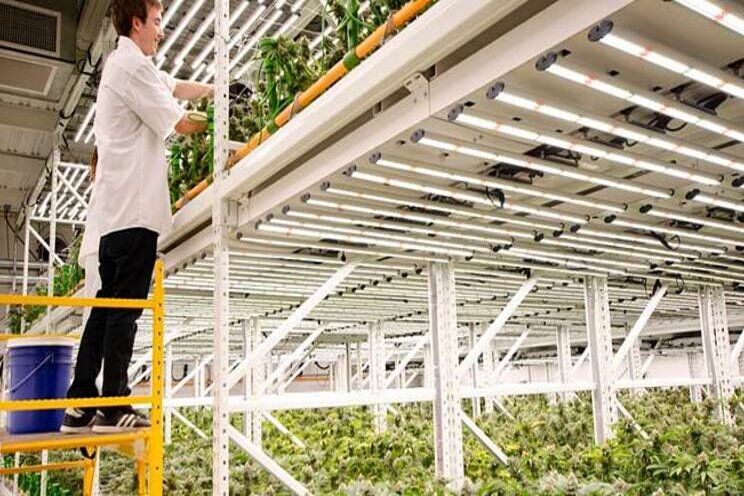4 convincing reasons to choose LED tech
Added on 15 May 2020

This wasn't the case even a few years ago. You'd have been hard-pressed to find cultivation operations eager to convert to or adopt LED systems over legacy options. But times have changed.
Here are four reasons why growers today are opting for LEDs:
1. Demand has driven costs down
Over the past decade, supply and demand have drastically reduced the cost of LEDs market-wide. In 2009, a single LED bulb cost $80, according to the Department of Energy. Today, it's $5.
As LEDs slowly grew in popularity worldwide in the early 2010s, manufacturing costs—particularly of LED chips—declined as production volume rose. In 2019, the global LED lighting market size across residential, commercial and industrial sectors was valued at $54 billion, according to Grandview Research. By 2027, its global market size is expected to exceed $127 billion.
2. LEDs are more efficient
Operationally, light efficiency can be loosely divided into three categories: lifespan, energy use, and heat emission. Consider the most common lighting systems used in commercial cannabis production: fluorescent tubes, high-pressure sodium, metal halide, and LEDs.
The average LED has a lifespan of 50,000 to 100,000 hours, which is two to four times longer than most fluorescent, HPS, and metal halide fixtures. The drastically longer lifespan of LEDs poses significant implications for cannabis cultivators operating at scale, who might otherwise be forced to replace thousands of fixtures more frequently.
Cannabis cultivation accounted for 1 percent of total U.S. electrical consumption in 2017, so it's no real surprise that energy efficiency is perhaps the most crucial factor for cannabis cultivators when considering a lighting purchase.
In 2017, the Department of Energy released a study entitled, "Energy Savings Potential of SSL in Horticultural Applications," and conducted a theoretical scenario "in which all existing horticultural lighting was assumed to switch to today's best-performing LED lighting products." Calculations showed that "annual horticultural lighting consumption would be reduced to 3.6 TWh (from 5.9 TWh), or 37 tBtu, which represents energy savings of 40 percent or $240 million." The study also found that LED lights can reduce electricity consumption by 24 to 30 percent per square foot of grow area across each category of indoor horticulture.
These findings are due in large part to LEDs' superior photosynthetic photon efficacy, or the photosynthetically active radiation photon output divided by input power. Today's leading LEDs—especially the ones designed exclusively for cannabis production—boast anywhere from 2.7 to 3.5 µmol/J, significantly higher than any other lighting type.
Just as significant to facility efficiency is the variation in method of heat transfer and the impact of infrared wavelengths on leaf surface temperature and plant growth. LEDs transfer heat through convection directed away from the plant, while HPS fixtures, for instance, direct heat onto the plant in the form of infrared light, raising leaf surface temperature and increasing HVAC sensible load and operational expenses through greater wattage demand.
3. LEDs enhance plant expression
Because of cannabis's federal classification as a Schedule I drug, there had been preciously little research conducted about its health benefits and its myriad effects on the endocannabinoid system, despite its potential to have a positive impact on both.
The cannabis industry is also reckoning with relics of the illegal cannabis market, which undoubtedly placed too much emphasis on overly simplistic classifications like "sativa" and "indica," and tended to prioritize potency—measured as THC percentage—over more nuanced assessments of characteristics such as cannabinoid and terpene profiles.
Those generalizations are still very much alive in today's legal cannabis market. Strain traits like aroma and visual aesthetic are still major drivers of consumer purchasing behavior, but they do not adequately account for the plant's natural complexity. To date, researchers have identified a few hundred cannabinoids as well as hundreds of terpenes and flavonoids that give various strains their signature odors and tastes.
As our knowledge of these crucial components of cannabis grows, so too does our ability to study how environmental conditions promote or inhibit plant expression and upregulation of metabolites.
Perhaps the greatest benefits of LEDs compared to other forms of lighting are their unparalleled control of light intensity, spectrum, and low heat emission. Since LEDs give off less heat onto the plants themselves, cultivators are able to place them closer to the canopy without causing deleterious effects to the plant.
When cultivators can place lights closer to the canopy—or even beneath the canopy—and have full control over intensity and spectra, they'll begin to see enhanced plant expression. Recent studies have shown that creative deployment and spectral use of LEDs can both "increase bud yield and modify cannabinoid and terpene profiles.
Cultivators in the field are seeing similar results. Eve Farms, a California-based cannabis producer, reported an 11 percent increase in cannabinoid and terpene production after switching to LEDs, and also saw entirely new cannabinoids emerge that were completely absent under HPS lighting.
4. LED use improves KPIs
Many cannabis cultivators are reporting increased production cycles, improved yield, more uniform consistency, reduced cost-per-pound, and other critical operational and revenue-driving KPIs after converting their facilities to LEDs. For example, MedMen converted a single-tier indoor facility using HPS to a multitier facility using LEDs with excellent results. It decreased cycle time on eight-week strains by as much as 25 percent, reduced the cost-per-pound of product by 75 percent, doubled production per square foot and increased crop yield by 157 percent.
The type of lighting system a cultivation facility adopts always has repercussions that affect every other area of cannabis operations and production: plant transpiration, air, and leaf temperature, heat emission, HVAC load, and ultimately business-critical KPIs that have to be met amid increasing market competition. Simply considering the upfront premium cost of a light fixture does not account for these factors, and cultivators should always develop production plans and financial forecasts that can influence whether they move forward with LED or legacy systems.
Source: Green Entrepreneur
Image credit: Fluence by OSRAM
Source: GreenEntrepreneur
More news















